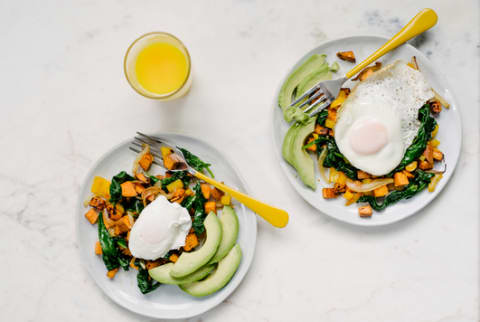Advertisement

The days of a set three meals per day are over. With more people becoming interested in personalized nutrition and finding out what works right for their individual bodies, the more they're realizing that they can help write new rules about what you should be eating and when.
People are redefining their mealtimes (or lack thereof) on their own terms and finding new ways to eat well that suit their lifestyles and health goals. This could mean eating smaller meals more regularly or simply changing the definition of what a traditional breakfast might look like.
Or maybe you like your three square meals a day (hey, that's cool too), but you're looking for a way to shake things up. Whatever you eat and drink throughout your day, we hope you do it in the way that helps you feel your best.
Turn sweet into savory.
With added sugar increasingly becoming a concern for many people, finding something savory and sustaining to eat at breakfast can set the tone for a low-sugar day.
Savory overnight oats or oatmeal? Add an extra pinch of salt to a serving of 100 percent whole grain Quaker Oats soaked overnight in your favorite milk, maybe a sprinkle of cheese, put an egg on it, and you're in business for a flavorful morning.
Pancakes or flatbread made from chickpeas, called socca, can be great for both savory and sweet toppings, but they're particularly nice when topped with hummus (we like Sabra) and some veggies for a low-sugar option.
Want to try this savory breakfast? Look no further than blogger and author Lindsey S. Love's savory socca from her book Chickpea Flour Does It All.
Trick out your latte.
Turmeric, beet, and blue green algae are all making an appearance in new guard lattes, from places like Bluestone Lane in New York City and The End in Brooklyn, giving you a rainbow of alternatives to a typical cup of joe.
These ingredients combined with frothed milk (almond and coconut milks are our favorites) are more than just an energy boost—they serve as tasty tonics that can be sipped any time of the day.
Breakfast for dinner
Maybe the most tried and true application of throwing traditional meal rules out the window, breakfast for dinner will never get old. Most breakfast dishes are generally quick to make, made from simple ingredients, and are comforting favorites.
Shakshuka (a Middle Eastern tomato stew topped with eggs), savory oats, omelets, and crepes all have a place at the dinner table.
Use smoothies to bridge the gap.
Smoothies are great because you can pack them with fruits, vegetables, protein (hello, almond butter and hemp seeds), healthy fats (think avocado), and superfoods (like maca, turmeric, or cacao). They can range from the full-on breakfast-bowl variety (smoothie bowls are having a moment, if you haven't noticed) to something to be sipped on the go.
For next-level smoothie inspo, we look to @LeeFromAmerica and @breakfastcriminals on Instagram.
Smoothies can be a great in-between kind of meal, too. You can whip one up to sustain you through a long morning of meetings or grab one to load up on greens for a day of more balanced eating.
Mix up your grain game.
Super grains and pseudograins make a great addition to typical breakfast oats. You can find other grains like wheat, rye, and barley mixed into your favorite oats.
Baked goods are getting alternative grain makeovers, too. And what was once considered niche gluten-free territory is now becoming more about adding new flavors and texture with grains like buckwheat, sorghum, chickpea, and gluten-free oat flours.
In Alanna Taylor-Tobin’s (of The Bojon Gourmet blog) cookbook Alternative Baker, she outlines how to use different types of flours to your advantage.
Sip your day away.
Quenching your thirst is important, but now that there are so many healthy options that provide everything from probiotics (like kombucha) to sleep aids, we find ourselves sipping with purpose.
Because being dehydrated is often confused with hunger, staying hydrated can help reduce cravings, giving individuals more accurate insight into when they're actually ready to eat. Drinking water, herbal tea, and flavored sparkling water throughout the day is a great way to tune into what your body actually wants, empowering you to eat what and when it feels good for you.


















